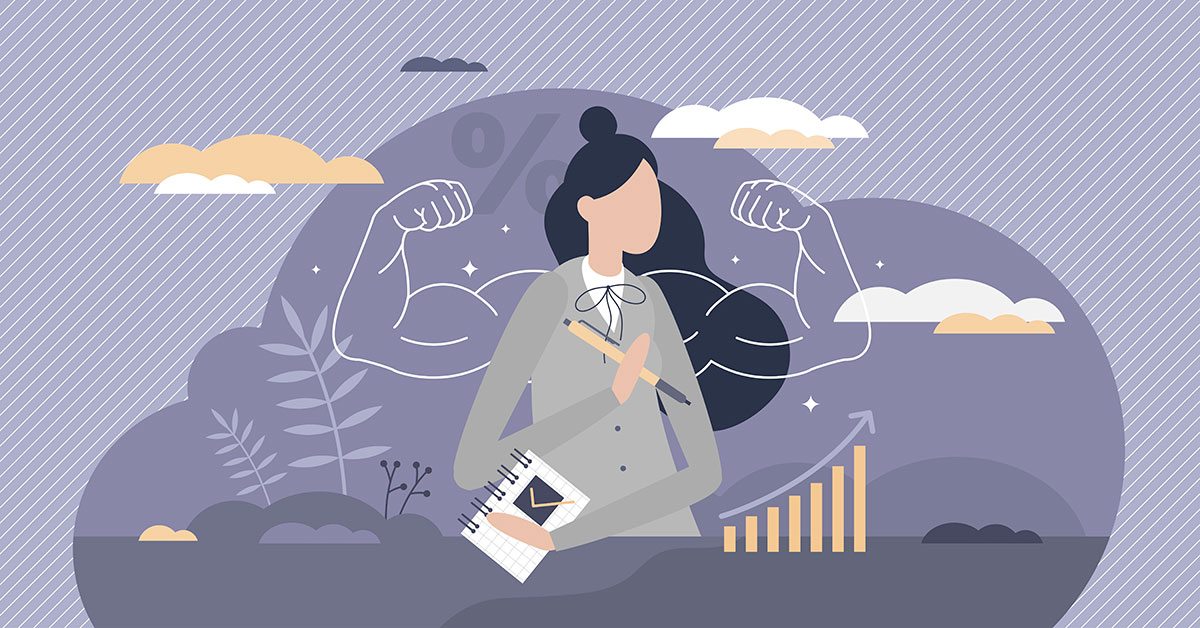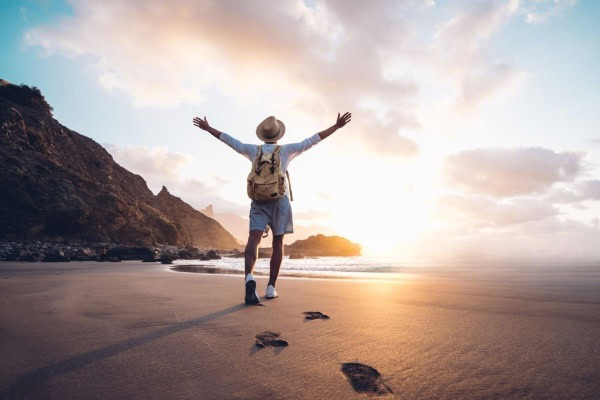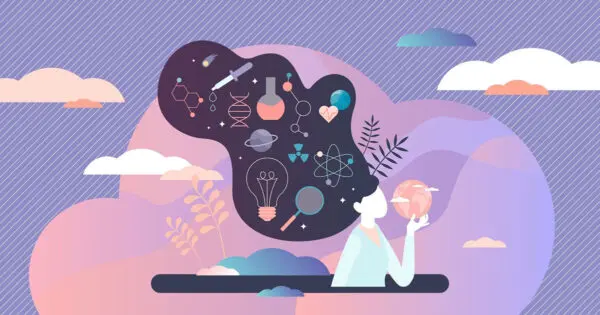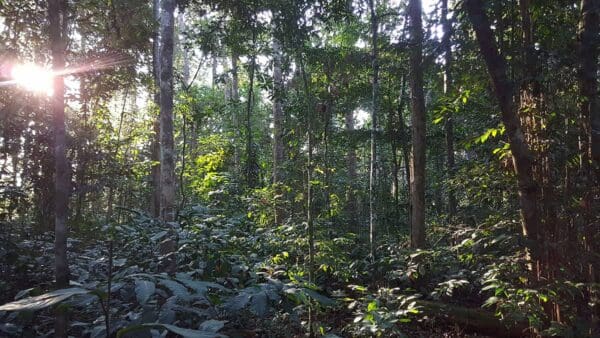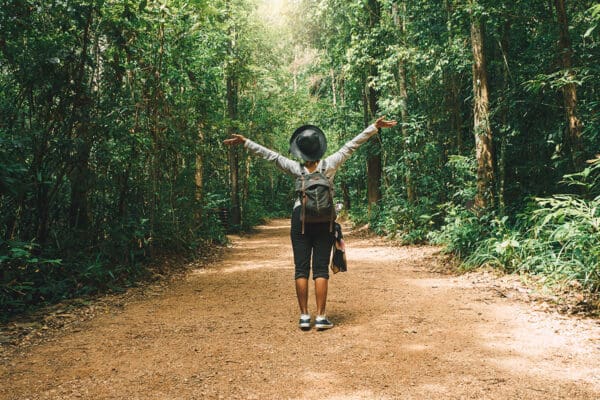In the early 20th century, the Bantu people of the Congo Basin wanted to avoid Christian missionaries’ influence, so they retreated farther into the forests to continue living their traditional lifestyle and practicing their spiritual beliefs.
There, they encountered Pygmy tribes, who eventually taught them how to use the root bark of Tabernanthe iboga to stave off hunger (confirmed later by studies on appetite suppression), thirst, and fatigue. They also learned to use iboga root bark for initiation ceremonies and healing rituals in larger doses. These exchanges would eventually create the Bwiti belief system, a recognized religion in Gabon. And eventually, the psychoactive molecule found in iboga would come to be used as a treatment for people experiencing substance dependencies.
Those who seek help for dependencies in the United States are often stigmatized and shamed for their drug use, arguably because media and propaganda only paint drug use as a moral failing and character flaw. But compassion and ingenuity, alongside the observational evidence of ibogaine’s efficacy, inspired a vast network of researchers, advocates, and people who use drugs to develop the ibogaine treatment networks we know today.
Ibogaine Providers and the Roots of a Medical Subculture
When Howard Lotsof stumbled onto the addiction interrupting effects of ibogaine in 1962, he was struggling with heroin addiction at a time when addictive behavior was poorly understood. Sharing it among his friends with similar dependencies, Lotsof immediately created a peer-support network for ibogaine administration. One may wonder, had Lotsof not been seen in a stigmatizing light by the general public, then perhaps this treatment would have been brought to the mainstream sooner.
As it stood, it took Lotsof decades to secure research studies using ibogaine. Establishing a network of researchers, clinics, and an ibogaine source in Gabon, Lotsof worked to legitimize the treatment that was becoming well-known among opiate users and ibogaine providers worldwide who are often connected through online networks. While some people use iboga root bark, most people work with a concentrated form of an alkaloid from the root bark called ibogaine.
Sustainability issues in more recent years have led to a semi-synthetic process being used to extract the alkaloid ibogaine from a more abundant African tree, Voacanga africana. The method for synthesizing Voacanga-sourced ibogaine was also part of this network of providers and the medical subculture that saved the lives of thousands of people over the years.
In a move that counters typical thinking among drug developers, Chris Jenks, a Ph.D. chemist, published open-source protocols for synthesizing Voacanga-derived ibogaine, helping to minimize the ecological impact on Gabon’s forests where the less sustainable but more concentrated plant source of ibogaine lives.
Ibogaine and the Stigma of Opiate Use
People who use opiates have long faced stigma and prosecution, and unfortunately, so too have the doctors that have tried to help those suffering from dependence. Last century the grandfather of the drug war, Harry J. Anslinger, prosecuted doctors for treating people for opiate dependencies. Today, people who are prescribed opioids are often subjected to stricter government interference than other patients and the social stigma can prove deadly.
The use of ibogaine originated among a marginalized group seeking self-treatment in the 1960s. It morphed into ibogaine providers running treatment centers without medical degrees or credentials, often by people who had felt stigmatized for years prior to finding ibogaine. In recent years, advocates have been pushing for its legality and recognition as a medical treatment to address opioid dependency — but this is not without opposition from within the medical community.
Many ibogaine advocates believe it hasn’t been developed because marginalized groups, like people who use drugs, tend to fall outside of the interest of most pharmaceutical developers. Over 20 million Americans meet the requirements for substance use disorder, and advocates of ibogaine treatment have robust evidence of its efficacy. But research is often labeled as unscientific and disregarded due to their lack of credentials.
Activism can feel like a fitting response to the sense of marginalization, and people like Dana Beal have dedicated enormous efforts to shifting the paradigm of healthcare. Beal, the founder of the Yippies and Cures Not Wars, might be one of the loudest voices when talking about the benefits of ibogaine and advocating for legalization.
Ibogaine has a long history of activists who provide it as an act of civil disobedience toward public health. It is safe to say that while there are more providers now than ever, the original principles that compelled people to make ibogaine accessible to those who are historically marginalized remains the same for many.
Dr. Alper and the Ibogaine Medical Subculture
Dr. Kenneth Alper, the lead researcher of many early and current ibogaine studies, resorted to funding his own ibogaine trials. Alper coined the term “medical subculture” in a paper he wrote about ibogaine in the Journal for Ethnopharmacology in 2008. According to Alper:
“The ibogaine subculture is not a counterculture because its identity is not defined on the basis of opposition to conventional medicine. The subculture is to a significant extent an innovation by its participants in response to a demand for a treatment that is unavailable in the conventional medical setting. Although it involves alternative means, the ibogaine subculture shares with the conventional medical culture the common goal of providing treatment, which it emulates in the medical model type, or the utilization by lay treatment providers of medical tests for pretreatment evaluation. Criminality per se is not a significant focus of the subculture, which exists because of ibogaine’s lack of availability within the institution of clinical medicine, and not its illegality.”
This medical subculture continues to exist because of passionate people who believe in the healing potentials of ibogaine therapy. This community includes cutting-edge scientists and medical professionals. Unfortunately, it also includes a growing number of desperate people labeled “treatment-resistant” by friends, family, and medical professionals. Those dismissed by others may identify with a subculture where they are afforded dignity and respect based on their humanity, not their sobriety.
The Providers Who Paved the Path for Ibogaine Therapy
Howard Lotsof ingested ibogaine in 1962 — five years before the U.S. made it illegal — and was surprised to find his heroin dependency eradicated. Following his exciting discovery, he gave ibogaine to some of his friends, several of whom were dependent on heroin. Arguably the first “ibogaine provider,” Lotsof successfully patented ibogaine in 1985 as a rapid treatment for short-acting opiates.
Lotsof also patented ibogaine as a treatment for several other substance use disorders, such as cocaine and alcohol dependency. Finally, he patented ibogaine for poly-drug use, as well. The patents led to a clinic being established in the Netherlands where Lotsof ran his studies and research, despite not having a degree in anything related to science or substance use. It was a single fatality in 1993 that would end his Netherlands project.
After speaking to a friend who used ibogaine for his alcoholism in the late 1980s, Eric Taub reached out to Lotsof, wanting to know more about ibogaine. Lotsof sent Taub transcripts and reports regarding ibogaine. He was convinced that he wanted to be more involved with ibogaine’s medical subculture based on this information alone.
Taub set off to Cameroon with his life savings from selling jewelry on the streets of New York City and smuggled ibogaine back in the bottom of his shoe. He completed hundreds of treatments, constantly evasive about where the treatments were being held; rumors ranged from the Caribbean to luxury yachts in international waters, Central America, and hotel rooms in Florida.
Taub treated and trained people who became ibogaine treatment providers in Mexico and Central America, some of them still active today. This partly kickstarted the movement of overseas providers and treatment centers. They refined the underground model, leading us to where we are currently.
Taub made a specific note that ibogaine appeared to work well for obsessive-compulsive disorder (OCD) and neurotic tendencies, which he also described as “reactive” behaviors to environmental cues or a learned, subconscious determined behavioral pattern.
Evolutions of Care Among Ibogaine Providers
Clare Wilkins, a world-renowned ibogaine provider, made a name for herself by developing safer protocols for ibogaine treatment. In particular, she has developed a cumulative, low, and repeated dosing methodology. In this protocol, individuals are slowly introduced to ibogaine with repeated, smaller doses while integrating the medicine along with psychotherapy and other alternative methods of healing. Ibogaine dosing will continue usually for several weeks which allows a subtle, but safe process of ingesting a cumulative amount of ibogaine. This method may be a safer answer to the rapid flood dose protocol most centers adhere to — with the appropriate training and center set-up.
However, as all ibogaine treatments require a high level of safety, a longer protocol requires long-term medical monitoring and vigilant safety procedures, plus a provider who is thoroughly trained. Still, new ways to work with ibogaine are exciting and groundbreaking, and also may give the option to more people interested in treatment who might otherwise be excluded.
In Wilkins’ 2017 study on methadone dependence, a participant was slowly given doses of ibogaine over six weeks while simultaneously decreasing methadone. Findings showed that the cascading accumulation of noribogaine reduces tolerance and dependence over a cumulative period of time. While the participant reported no visionary effects, they reported psychotherapeutic insights regarding events from their life and processed them without emotional attachment.
Psychiatric Research and the Insights of Ibogaine Experience
Because the medical subculture of ibogaine exists outside the allowable treatment model, the strict boundaries found in clinical trials are often permeable. Subjective experience and personal insights gained during an ibogaine experience are woven through the documented research compiled on ibogaine. Anecdotal themes reveal insights and benefits of the psychedelic ibogaine experience that medical researchers frequently dismiss but clients and providers recognize to be therapeutic.
Ibogaine Providers Honor the Psychedelic Experience
Providers have popped up worldwide over the last few decades, but a small group of long-time providers has consistently remained in the field. These providers usually have a direct lineage to either Lotsof or Taub. More recently, Wilkins has paved a path for female providers in the industry and is making a significant impact as an advocate for the safe administration of ibogaine.
If drug developers prioritize the opiate interrupting properties of the drug over the psychoactive properties, doctors may forget this medicine is rooted in spiritual healing, compassionate community, and self-reflective integration over many months. In the meantime, novel ibogaine analogs are being developed to intentionally remove the psychoactive component of ibogaine.
As ibogaine therapy goes mainstream and becomes ever more clinical, there is also a risk that newly trained providers who are unfamiliar with psychedelics will not learn about the critical role that psychedelic mind states, visions, and integration play in the therapeutic process.
And yet, looking back at clinical research on ibogaine, we can see the value that the psychoactive and visionary experience of ibogaine has had for clients themselves:
Many participants of research studies mention that the visionary aspect of their ibogaine experience gave them deep insight into the reasons they sought out treatment. Confirming Claudio Naranjo’s early studies, participants repeatedly reported seeing difficult childhood memories, experiencing psychological introspection, and observing scenes that traced back to the roots of their drug use or why they sought out treatment.
A follow-up study investigated what life was like following ibogaine treatment. Despite abstinence or drug use, 88% reported their interpersonal relationships improved. Individual participants reported having more empathy, feeling empowered, and more connected to others. Inner peace, feelings of happiness, and tolerance of challenging emotions or situations have also been reported in follow-ups after opioid detoxification with ibogaine.
In a study with veterans suffering from symptoms of PTSD and cognitive impairment, 84% of participants reported ibogaine to be spiritually and psychologically meaningful. Overall, the participant’s well-being and mood were increased. Suicidal ideation, symptoms of PTSD, depression, anxiety, psychological flexibility, and cognitive impairment all improved. Over two-thirds of participants documented an improvement in their personal views of the nature of reality and the universe.
In Brazil, a follow-up analysis was conducted on a 12-month study on substance use and ibogaine. Overwhelmingly, participants said the dream-like visionary state played a significant role in their recovery. Participants said they saw a path for their future and felt more comfortable with who they were. Many described visions and insights into family memories and dynamics. Cognitive improvement and increased emotional awareness were also reported.
But would a non-psychoactive ibogaine analog have the same impacts for clients?
Ibogaine During COVID-19
During the COVID-19 pandemic, there was a surge in accidental overdoses involving fentanyl with an increase of 38.4% over 12 months. Ten states reported a full 98% increase in synthetic opioid deaths. Of these, 26.5% involved contaminated cocaine, and 34.8% involved contaminated methamphetamine. This all demonstrates a clear need for alternative solutions beyond the scope or abilities of the current healthcare paradigm.
However, COVID-19 also prevented many ibogaine treatment centers from being operational due to travel bans and transmission concerns. Slowly, ibogaine providers found ways to work again. Some providers risked moving back to the U.S. and worked underground, setting up full medical centers with staff and equipment, others had minimal set-ups, with an attitude that some monitoring is better than nothing.
There are stories of centers setting up quarantines, requiring COVID-19 tests before and after arrival, and there are even stories of providers trying to get access to their own tests in foreign countries. But the central theme is that many centers had to shut down for months as providers developed new pandemic protocols and ethics around travel during a pandemic. Most centers slowed down and stopped taking multiple clients at once, leaving many prospective clients on long waiting lists or willing to take chances with less reputable centers.
Ibogaine Activism Integral to the Future of the Medical Subculture
Among all the people who are a part of the ibogaine treatment process lies another group of people responsible for spreading information and raising awareness about ibogaine. Ibogaine activists have been around since the beginning. While some treatment providers and integration specialists are activists in their own right, some people solely dedicate their time to advocating for ibogaine.
Ibogaine activism does not come without risk. Dana Beal has had multiple prison stints, underground providers in the U.S. have been arrested, and the unfortunate providers who have witnessed fatalities are often faced with murder or manslaughter charges or the choice of fleeing a country, which may be ethically questionable. The activists who continue to advocate for the better treatment of people who use drugs and those with mental health ailments may find themselves marginalized as they advocate for ibogaine access.
Ibogaine Must Adapt with A Changing Landscape of Clients
Ibogaine providers exist amidst a changing client landscape. Providers are responsible for developing safe protocols and methodology to meet their diverse clientele needs. Over the last 10-20 years, some ibogaine providers have seen an influx of clients with complicated medication regimens and an increase of novel psychoactive research chemicals and synthetic opioids. As ibogaine gains popularity, ibogaine providers must deal with an array of new circumstances.
Protocols and methodology are often updated as anecdotal evidence and research continue to grow — and as more experiences with novel substances and medication, interactions occur. One example is opiate detox protocols that have worked for clients on short-acting opiates such as heroin or oxycodone for decades. Ibogaine providers have had to change their protocols in response to the increase of fentanyl in the U.S.’s heroin supply, and the increase of people wanting to get off buprenorphine (aka Suboxone), a semi-synthetic “maintenance opioid” prescribed to replace the use of heroin.
Just as underground providers have shaped the history of ibogaine therapy, the future is sure to be shaped by them as well — at least so long as ibogaine providers are forced to operate underground. But if the compassion, ingenuity, and attention to patient care and subjective experience can be integrated into the emerging ibogaine industry, then the original goals of the founders and advocates that birthed this movement may yet be realized and legitimized.
